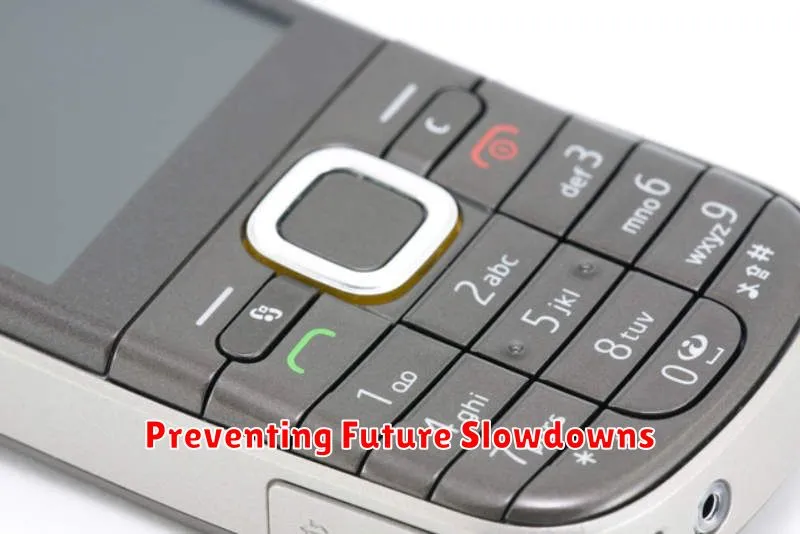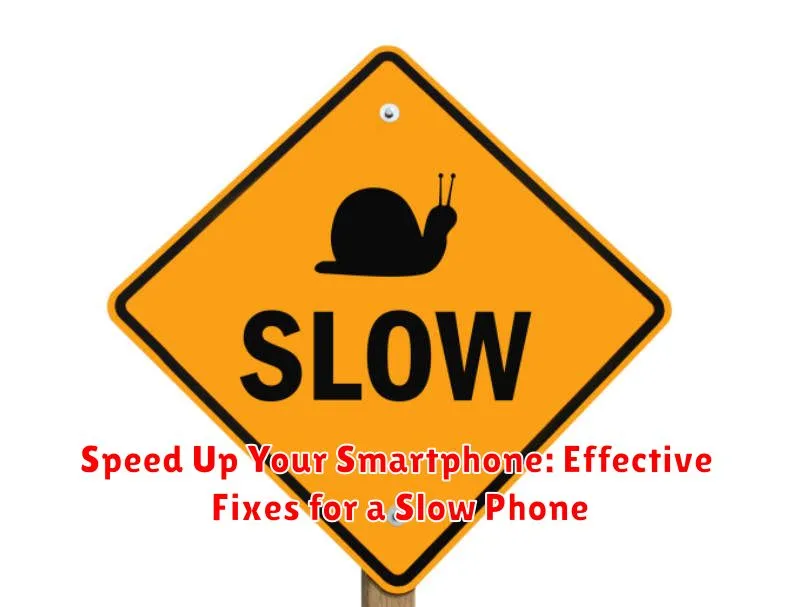Is your smartphone running slower than a snail? Do app launches feel like an eternity? A sluggish phone can be incredibly frustrating, impacting productivity and hindering your daily digital life. This article will provide effective fixes to speed up your smartphone, addressing common causes of slow performance and offering practical solutions to reclaim a responsive and efficient device. Learn how to identify performance bottlenecks, whether due to low storage, demanding apps, or software issues, and discover actionable steps to optimize your phone’s speed. From simple tweaks to more advanced techniques, we’ll cover a range of strategies to revitalize your slow phone and get it back to running smoothly.
Whether you have an Android or iOS device, a slow phone can affect anyone. This guide provides clear, concise instructions to help you troubleshoot and resolve the underlying causes of your phone’s sluggishness. We will explore strategies such as clearing cache, managing apps, updating software, and other optimization techniques to breathe new life into your device. By following these effective fixes, you can significantly improve your phone’s performance and enjoy a more seamless and enjoyable mobile experience. Say goodbye to frustrating lag and hello to a faster, more responsive smartphone.
Identifying the Causes of a Slow Phone
A sluggish smartphone can be frustrating. Before attempting any fixes, it’s crucial to pinpoint the root cause of the slowdown. Several factors can contribute to decreased performance.
Aging Hardware: As phones get older, their hardware may struggle to keep up with the demands of newer apps and software updates. Processors and RAM can become bottlenecks.
Full Storage: Insufficient storage space can significantly impact performance. When your phone’s storage is nearly full, it has less space to operate efficiently.
Background Processes: Numerous apps running in the background consume resources and can slow down your device, even when you’re not actively using them.
Outdated Software: Running an older version of your operating system or apps can lead to compatibility issues and performance problems. Updates often include optimizations and bug fixes that improve speed.
Resource-Intensive Apps: Certain apps, particularly games and multimedia editing software, demand significant processing power and memory. Using these apps extensively can strain your device’s resources.
Clearing Cache and Unnecessary Data
Cached data and temporary files accumulate over time, consuming valuable storage space and potentially slowing down your phone’s performance. Regularly clearing this data can significantly improve your phone’s speed and responsiveness.
Clearing the app cache can resolve issues with specific apps that are running slowly or crashing. Most phones offer a way to clear the cache for individual apps or all apps at once. This process removes temporary files associated with the app without deleting your app data or settings.
Clearing browsing data, including history, cookies, and cached images, can free up space and improve browser performance. Similar to app caches, this process doesn’t delete your saved passwords or bookmarks.
Deleting unnecessary files, such as downloaded files you no longer need or large media files, can reclaim significant storage space. Review your downloads folder and media library regularly to identify and remove files that are no longer required.
Managing Apps and Background Processes
Applications running in the background consume processing power and battery life, even when you’re not actively using them. Managing these processes is crucial for maintaining a snappy phone.
Begin by identifying resource-intensive apps. Your phone’s settings usually offer a way to view app usage statistics. Look for apps consuming a disproportionate amount of battery or CPU. Consider uninstalling apps you rarely use. For necessary apps, explore their settings. Many apps allow you to restrict background activity, limiting their impact on performance.
Force stopping unnecessary background processes can provide an immediate performance boost. Access your phone’s recent apps list and close those you don’t need running. Be mindful that the system will automatically restart essential processes as required.
Updating Software and Operating System
A frequently overlooked yet crucial step in maintaining smartphone performance is keeping both apps and the operating system updated. Software updates often include performance enhancements, bug fixes, and optimizations that can significantly improve your phone’s speed and responsiveness. Furthermore, these updates often address security vulnerabilities, ensuring your data remains protected.
Regularly check for updates for both your operating system and individual apps. Most modern smartphones offer automatic update options, which can simplify this process. For apps, you can typically find update options within your device’s app store. For operating system updates, navigate to your phone’s settings menu and look for a “Software Update” or similar option.
While updates can sometimes require a restart and a small amount of time to install, the long-term benefits for your phone’s performance and security make them essential.
Optimizing Storage Space
A phone burdened with excessive data can become sluggish. Freeing up storage space can significantly improve performance. Storage optimization involves identifying and removing unnecessary files and apps to create breathing room for your device’s operating system.
Begin by reviewing your downloaded files and media. Delete any large files, unused apps, or duplicate photos and videos. Consider using cloud storage solutions like Google Drive or iCloud to back up and store large files off your device.
Clearing the cache of individual apps can also help reclaim storage. Access your device’s settings and navigate to the storage or app management section to clear individual app caches.
Many devices offer built-in storage analysis tools. These tools can quickly identify large files and folders, offering suggestions for what can be safely removed.
Checking for Malware and Viruses
Malware and viruses can significantly impact your smartphone’s performance. A compromised device might exhibit sluggishness, unusual battery drain, and unexpected app crashes. Therefore, regularly scanning for malicious software is crucial.
Most reputable antivirus software providers offer mobile applications that can detect and remove threats. Install a reliable antivirus app from a trusted source like the official app store.
Once installed, run a full system scan. This process might take some time, depending on the amount of data stored on your device. Follow the app’s prompts to quarantine or delete any detected malware.
Prevention is always the best strategy. Be cautious when downloading apps, especially from sources other than the official app store. Pay attention to app permissions and avoid granting access to sensitive data unless absolutely necessary.
Resetting Your Phone to Factory Settings
A factory reset can be a powerful solution for a persistently slow smartphone. It restores the device to its original software state, eliminating accumulated data, rogue apps, and corrupted files that might be hindering performance. However, it’s crucial to understand that this process erases all data on your phone, including photos, videos, apps, and settings. Back up your important data before proceeding.
The process for resetting varies depending on your phone’s operating system and manufacturer. Generally, you can find the factory reset option within the “Settings” menu, often under “System” or “Backup & reset.” Follow the on-screen prompts carefully. After the reset, your phone will restart and guide you through the initial setup process as if it were new.
While a factory reset can significantly improve performance, it should be considered a last resort after exploring other troubleshooting options. If your phone continues to experience slowdowns after a reset, it might indicate a deeper hardware issue.
Hardware Considerations and Upgrades
While software optimizations can significantly improve performance, hardware limitations can ultimately bottleneck your smartphone’s speed. Consider these hardware-related factors:
Storage Capacity
A phone nearing its storage capacity can experience significant slowdowns. Check your available storage and consider deleting unnecessary files or apps. If your phone supports it, using a microSD card can offload some data and free up internal storage.
RAM
The amount of RAM plays a crucial role in multitasking and overall responsiveness. Unfortunately, RAM is usually not upgradeable in smartphones. If your phone consistently struggles with multiple apps, it might be time to consider an upgrade to a device with more RAM.
Boosting Performance with Third-Party Apps

Several third-party apps are designed to enhance smartphone performance. These apps often focus on specific areas like memory management, storage cleanup, and battery optimization. However, it’s crucial to choose these apps wisely. Some apps can be ineffective or even detrimental, consuming more resources than they save.
Look for reputable apps with positive user reviews. Avoid apps that promise unrealistic performance gains or require excessive permissions. Before installing any performance-boosting app, research its functionality and reputation thoroughly.
Examples of app categories that may help:
- Cache cleaners: These apps help clear temporary files and free up storage space.
- RAM managers: These apps aim to optimize RAM usage, closing unnecessary background processes.
- Game boosters: These apps dedicate resources to running games smoothly, potentially improving frame rates and reducing lag.
Note: Over-reliance on these apps can sometimes be counterproductive. Regularly restarting your device and managing your apps manually can be just as effective, if not more so.
Preventing Future Slowdowns

Proactive measures can help maintain your smartphone’s performance over time. Regularly clearing app caches and data can prevent unnecessary file buildup.
App Management is crucial. Uninstall unused apps to free up storage and system resources. Disable pre-installed apps you don’t use, rather than completely removing them, to avoid potential system instability.
Software Updates often include performance enhancements and bug fixes. Keeping your operating system and apps updated ensures you benefit from these improvements.
Storage Management plays a vital role. Avoid filling your phone’s storage to capacity. Maintain a reasonable amount of free space for optimal performance. Regularly transfer photos and videos to cloud storage or a computer.
Mindful App Usage can also prevent slowdowns. Close apps running in the background that you aren’t actively using. Limit the number of apps you have open simultaneously.

